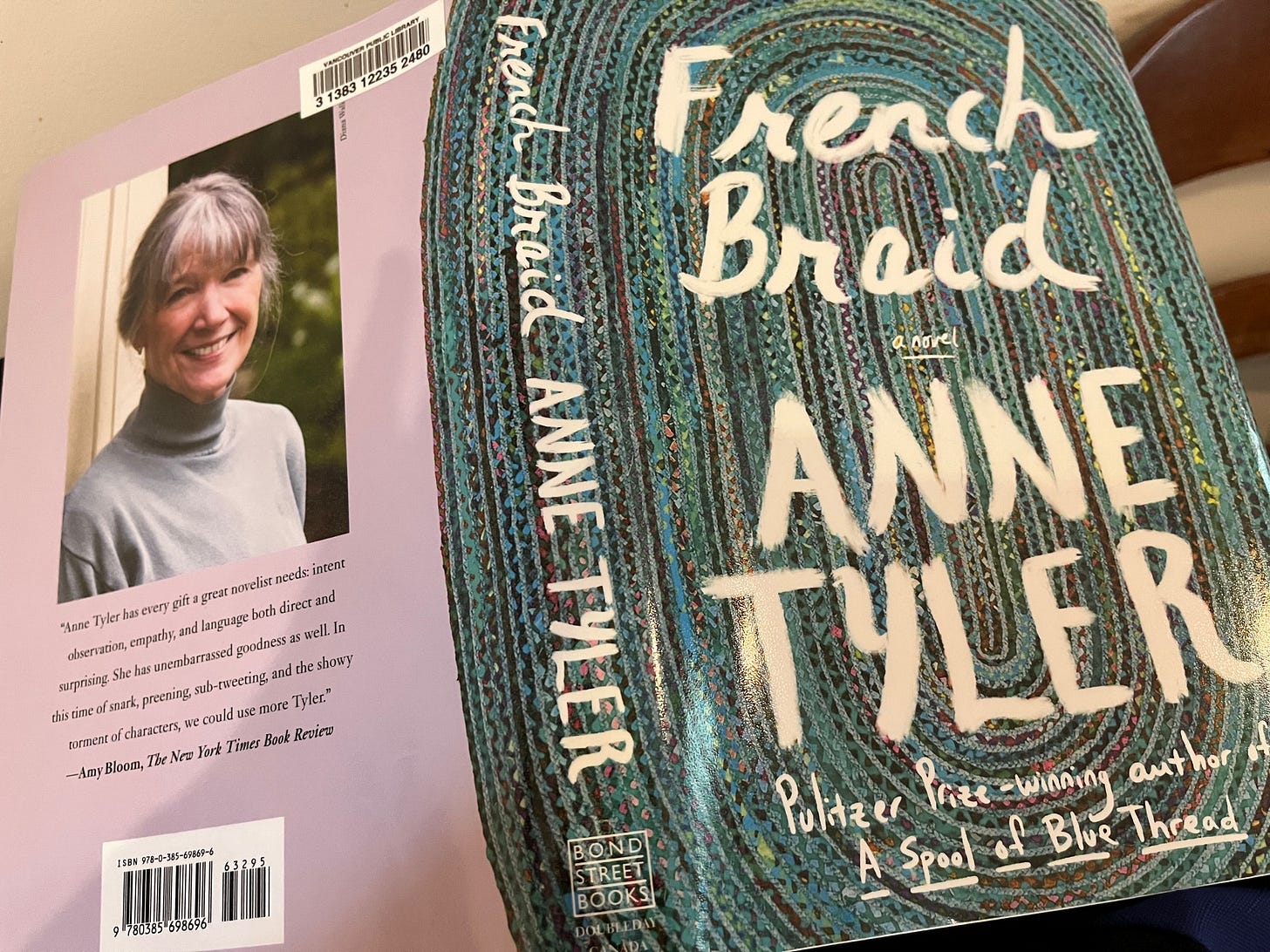As you might guess from the August prompt, I’m thinking about POV (point of view) lately, and working on a lengthier post on this topic, which I hope to complete soon. (Interesting task—weaving writing through hiking mountains and trips to Seattle for music. We are so fortunate that writing is an art form that can be practiced in snippets of time!)
Not long ago, I read Tyler’s A Spool of Blue Thread. These two novels share so much. Granted, many of Tyler’s stories carry similar themes and motifs. But her movement with POV is something that gives me pause. At times I find myself hungry to stay with one. Yet the pieces of all her works really do quilt, and the whole functions in the expansive way I want in a novel. So… I’m torn.
Between these two particular stories (which happen to be the most recent of her works that I’ve read), there is the wayward or misunderstood brother (with two sisters); two related characters with the same names (in this case, male and female cousins, both named Robin, and in Blue Thread, two men who have married two sisters); and so on. It’s interesting to see these same-threads popping up. “They” say that writers write the same story over and over, and perhaps it is more apparent as we age. (I remember hearing Jane Rule speaking with Timothy Findley, and saying she was going to stop publishing; she was in fear that she would be repeating herself. But I wish she’d never stopped. I could have read her repetition.)
In French Braid, there are certain threads—maybe I should say strands—that feel to me to be better developed than in Blue Thread (the Pulitzer winner). So I wonder: if we do tell the same story over and over, is it with the hope that we are coming to a clearer and/or deeper understanding of it?
Again, this story is titled after an almost incidental piece—another commonality. It’s the sheer ordinariness of such pieces that, again, cause me to pause. (Interesting to see they chose to illustrate the cover with a braided rug, and not the hair-braid mentioned in the text.) I believe this is what makes the work so vibrantly real. Stories do not need to be filled with grandeur and fireworks. When writing contemporary (or relatively! Tyler’s work is often set in recent decades past) realism, I believe readers—and writers—are seeking and working with the day-to-day. We read Tyler to see how others negotiate, and for their emotions, or lack of. For those moments of clarity. For moments when we as readers have clarity around the character/s’ lack of. We have our own truth-moments as we read. And the same as we write.
“Connection with family” (or lack of again) is the theme here, and the opening chapter is a prologue of sorts even as it is labelled “1.” (Why aren’t all prologues “Chapter One”?) Here we see into the future, to a fractured family, whose collective brokenness extends to further generations who are also disconnected from family. And even potential family.
Tyler’s descriptions are one reason why readers return. There is nothing dramatic about these—but they are each a delicious moment of detail and recognition, of “Yes, that’s exactly how it is.”
Nature:
“One morning the Motts’ huge oak filled up with tiny birds, so many of them that all at once the bare tree seemed abundantly leafed, and they made a busy chittering sound like hundreds of scissors snipping.” (p. 102)
Character: (what one character observes about another says as much about the observer as the observed)
“She knew he came across as stuffy and too earnest, prone to telling the entire plots of movies and to making a low, place-holding humming noise any time he paused to search for words…” (p. 134)
Ageing… and still seeing some vision of the inner youth:
“She wore faded jeans and a tank top that exposed her withered arms, and her gray-blond ponytail was doubled back through its elastic to keep it out of the way.” (p. 207)
Other work that Tyler does well is to draw out into the clearest daylight what humans do to each other:
“So, this is how it works,” she said. “This is what families do for each other—hide a few uncomfortable truths, allow a few self-deceptions. Little kindnesses.”
“And little cruelties,” he said.
“And little cruelties,” she agreed, and she swung his hand between them.
He was relieved that she seemed so unimpressed by what he’d told her. Suppose she had looked at him differently, all at once! Suppose she’d said, “Oh yes, now that you mention it, I see that you are unlikable.”
But he should have trusted that she wouldn’t. Not his Greta. (p. 242)
Ah, but he (David) thought it, didn’t he? And what does that say?
~~~
I had to go back and read the opening—a rewarding decision—to realize that David’s son, Nicholas is the male character in that opening chapter, an almost walk-on character surely. Yet the one who evokes that some healing has taken place in this family. He is brave enough to walk away from the potential pain of a distancing person. Something to think about.
So Tyler’s shifting POV works with her theme/s. Ultimately, that’s what it comes to: does your decision around POV work with the story as a whole? The coupling of form and content—always a return to that in creating the fabric of your story. From our archives:
Thoughts on Anne Tyler’s work? These two in particular…? POV? Details?
~~~
Huge thanks to the half dozen readers who’ve joined as paid. To return home from hiking and to find you here means so much!
A pic of the stunning Mt. Baker, as from the tent:
Mt. Baker, WA, August 2, 2022 from Chain Lakes trail area







I really enjoy this post, which I've read twice now. I love how you call out moments that, as you say, keep bringing readers back to Anne Tyler.
I have read a lot of Tyler's books, but didn't fully appreciate her craft and her depth of understanding until I read A Spool of Blue Thread. That sent me back to her older work, and I went on a real two-year Tyler binge. I do enjoy her craft a lot, and I was delighted to read this post about that aspect of her work. But what keeps me so enthralled with her is the depth of compassion and understanding, and the way she sometimes makes me gasp in moments of that. There's a moment in French Braid that literally made me gasp. I won't identify it here because I hate spoilers, but readers may know which scene I mean if I simply say I love cats.
There's another Tyler novel that I've re-read several times now, and I think it's my favorite: The Amateur Marriage. In this also, she shifts POV, and I also really love the fact that each chapter or section can be a stand-alone story. Though the book really functions like a novel, I do like this feeling of it being linked short stories (not so very short). I also love the sharpness of each character, how well developed each and every character of this novel is. It feels economical and yet rich and full.
Thank you for such a great post. You've given me lots today.